We make a diet for birds correctly - how to feed the hens at home
The main purpose of keeping laying hens is to obtain eggs. That is why it is so important to take care of the health and productivity of the bird. Egg production directly depends on the quality and frequency of feeding. Providing good nutrition to chickens, you can get eggs all year round without interruption. How to feed your hens at home to increase egg production?
What can be fed to laying hens
Birds should eat 130-140 g of good quality feed every day. With insufficient nutrition, the bird stops rushing normally. Therefore, it is impractical to save on the diet. In order to correctly calculate the amount of feed, it is necessary to multiply the recommended mass of food by the amount of birds. In winter, the feeding rate is increased by 20%, which makes it possible to fully compensate for natural heat loss.
Experts recommend making a diet for laying hens based on:
- high quality grain mixture, which includes oats, wheat, barley, ground corn;
- wet mash, for the preparation of which boiled potatoes and other vegetables are finely chopped;
- additives that contain salt, chalk, bone meal, yeast and cake.
In the warm season, the diet of layers is supplemented with fresh grass, vegetable tops, roots and fruits. It is important to provide walking, so that the bird feasts on midges and worms. In the cold season, the diet can be diversified with hay, grass flour, dried nettles, clover and dandelions. The presence of sprouted grain, special vitamin and mineral supplements in the trough will significantly increase egg production.
The perfect diet for the summer
In the summer months, the diet of the hens changes dramatically. Chickens are free-range for a long period, getting themselves worms and grass. Experts recommend adding chalk or gravel to the menu.
A damp mash is perfect for morning feeding, and in the evening it is better to offer the bird a grain mixture. If the birds do not go outside, feeding should be provided 3 times a day. However, the grass should be given to the bird daily, as it contains a large amount of vitamins and fiber. For winter feeding, it is important to dry the straw in advance, which can be given in the cold season.
Advice! It is unacceptable to give the bird rotten grass.
To balance the weight of the laying hen and improve her egg production, it is important to adhere to the amount of feed and the frequency of feeding. It is imperative to change foods so that the morning diet does not repeat the evening one. For a bird that does not have free range, it is important to supplement the daily diet:
- grain mixture;
- grass;
- dung beetles;
- locusts and caterpillars.
It is important to inspect the bird in order to prevent the appearance of ticks, which contribute to the weakening of the laying hen and reduce its productivity.
The perfect diet for the fall
In the warm season, laying hens actively do their job and delight the owner with a large number of eggs. Closer to autumn, each of the chickens, having lost a lot of weight, brings only 1-2 eggs in 7 days. As a rule, the owner of the poultry house slaughters most of the birds that are more than 2 years old for meat. Only strong and young birds remain for the winter.At the beginning of autumn, laying hens begin a molting period, which they almost always have a hard time tolerating and lose activity and mobility, and an attractive appearance. In the fall, it is especially important to provide hens with good nutrition, which should consist of:
- fish meal;
- bone meal;
- cottage cheese and chalk;
- seashells and slaked lime;
- a large number of vegetables and fruits;
- sprouted wheat, barley and oat grains.
Food should be provided to the bird 3-4 times a day. After sunrise, add one-third of the daily amount of the grain mixture to the feeders. After a few hours, a damp mash is poured. It is also important to put a sufficient amount of dry feed in separate feeding containers, which should be freely available to the bird all day.
To increase egg production and weight gain during this period, it is important to provide poultry with sufficient corn and wheat grains.
Even in the summer, it is worth taking care of the nutrition of the chickens and drying a large amount of hay and nettles. It is also important to stock up on pumpkin and fodder beets, zucchini, old cucumbers, leftovers from the processing of sunflower seeds.
It is very useful to pour sunflower cake into the feeders in the cold autumn, pounded with a small amount of flour and water (you should get a consistency that resembles a wet mash).
The ideal diet for the winter
The most important step in caring for hens is during the cold season. Underfeeding poultry or improperly composing the diet can provoke the death of laying hens, which occurs against the background of a deficiency of nutrients in the body. Feeding quality food allows you to achieve good egg production for this period.
The ideal winter diet for poultry should be based on:
- Grains. More than 50-55 g of fresh dried grain mixture should be given to one bird per day.
- Mushrooms. For a day, you will need to cook 35-40 g of a mash, prepared on the basis of barley and oat flour for one layer.
- Potatoes. A healthy adult laying hen needs to eat 1 boiled potato daily.
- Oilcake, which is harvested in advance by farmers in early autumn. One chicken should be given about 7 g of macuha per day.
- Dried nettles and hay. The dried grass is poured into the feeders in the morning for the whole day, calculated for 10 chickens 100 g.
- Fermented milk products (experts recommend each hen to drink 100 ml of whey per day).
- Chalk and shells, which contribute to the formation of a strong eggshell, the skeletal system of the bird (it will take 3 g per day for one hen).
- Bone meal, which must be included in the diet in winter (2 g per hen).
- Common table salt at the rate of 0.4-0.5 g for each bird.
The ideal diet for the spring
With the onset of the spring thaw, laying hens begin to walk in the yard. Experts recommend feeding poultry food rich in vitamins and minerals. It is very important to pour in sufficient amount of sprouted grains, which will make up for the lack of vitamin E in the body.
Each chicken should receive 40-45 g of sprouted grains daily. It is important to add baker's yeast, rich in vitamin B, to the diet of layers (each bird will need about 3-4 g). Yeast should be mixed with a mash or mixed feed.
During the spring months, the laying hen should receive:
- 60 g of a grain mixture consisting of barley, wheat and oats;
- 55 g of wheat and oat flour, bran, on the basis of which wet mash is prepared;
- 15-17 g of straw or hay;
- 55 g grated beets, carrots and turnips;
- 12-17 g of cake, which increases the egg production of poultry;
- 5 g of eggshells and shells, containing a large amount of minerals and helping to strengthen the skeletal system of layers and feathers;
- 2.5 g table salt and bone meal.
Correct feed composition
Before you start preparing the mash on your own, it is important to determine the correct composition of such food and its amount.Experts recommend the following composition, which will help increase the egg production of the bird. To prepare, mix:
- yellow corn - 40 g;
- barley - 7 g;
- wheat - 30 g;
- sunflower cake - 10 g;
- fish meal - 7 g;
- yeast - 3 g;
- milk powder (skim) - 2 g;
- herbal flour - 5 g;
- chalk and shell - 3 g of each component;
- bone meal - 3 g;
- salt - 0.3 g;
- technical fat - 3 g.
Important! Also, potato tubers, raw potato skins, beets, and carrots are boiled and ground separately for the bird.
What is forbidden to give to layers
Not every product is suitable for chickens. Poultry feeding should be taken seriously, otherwise you can provoke the death of layers or a deterioration in their egg production. It is forbidden to feed the bird:
- Loaf, white bread. For nutrition, only black bread can be suitable, which is important to first dry it in the oven. After that, after soaking the bakery product in a bowl of milk, you can add the product to the feeder.
- Salted and fresh fish. If you wish, you can boil some fish and combine it with a damp mash.
- Sugar beet that causes severe diarrhea. Poultry should be fed exclusively on fodder beets, which do not provoke digestive system disorders.
- Tomato tops.
- Citrus fruits and their peels.
- Celandine.
- Sweet products.
What food will help you rush better
In the event that the egg production of a bird decreases, it is important to pay attention to the nutrition and health of the bird. The skeleton of every chicken contains calcium, which gets into the laid eggs. Inspection of the eggshell is important to determine calcium deficiency. A shell that is too fragile indicates a lack of a useful trace element. In order for the chickens to rush better, their diet should be supplemented:
- crushed chalk;
- shells of molluscs;
- eggshells (crushed).
Such feeding should be not only in the chicken coop, but also in places where birds are walking. If desired, you can add chalk and crushed shells to the feed for layers.
What to feed for fast growth
In order for the layers to grow quickly, you should prepare mashings for them, consisting of boiled and chopped:
- potatoes;
- carrots;
- zucchini and pumpkin;
- bran or ground grain;
- vitamin supplements;
- fish oil and trivitamin.
The mash is complemented with herbs, grass, a little garlic, and a feather of a batun onion. Before sunset, the bird should be poured into the bird feeder bran with vegetable ingredients or steamed grain with boiled, pre-chopped potatoes.
Important! Feeders with a damp mash in the sultry heat should be left for only a couple of hours. After that, the food is disposed of, as the food quickly sours and can cause upset stools in birds.
Feeding rates
Chickens are in search of food almost all daytime. That is why it is so important to follow the feeding standards so that overeating does not negatively affect the health of the bird. In order to maintain productivity, it is important to feed the birds 3 times a day. Only in the winter months the number of feedings can increase up to 4 times a day. However, first of all, it is important to pay attention to the breed peculiarity of the chicken and its well-being.
Important! For every 100 g of grain mixture, add 0.5 g of table salt.
In summer, green grass should be the basis of food. In the winter months, vegetable mash and hay should be taken as a basis.
Ideal daily ration for laying hens (g per bird)
|
Feed type |
Summer period |
Winter months |
|
Grain mix |
50 |
60 |
|
Mealy feed |
20 |
25 |
|
Oilcake, yeast |
7 |
9 |
|
Greens |
60 |
hay - 50 |
|
Vegetables |
50 |
60-70 |
|
Hay or herbal flour |
5 |
10 |
Feeding type
Each farmer chooses the basic type of feeding that suits his situation. There are several types of poultry nutrition, which are based on:
- Wet food (mash) that anyone can cook with their own hands. The owner of the poultry house feeds the birds with boiled and chopped potatoes, carrots, zucchini, pumpkin and fodder beets.The listed components are mixed with bran (milled grain). Also, the bird receives sufficient amount of grass or hay, depending on the season.
- Dry food, which can be purchased at any specialty store or prepared by hand. Such food is quite costly in terms of finance.
- Mixed feeding, in which in the morning hours a wet mash is poured into the feeders, containing enough bran and chopped vegetables. After lunch, chickens should be offered greens, crushed grains, vegetables and sunflower cake. And in the evening, the troughs are filled with grain and compound feed.
Feeding the hens is a very important step. Proper nutrition has a positive effect on the health of chickens and increases their egg production.



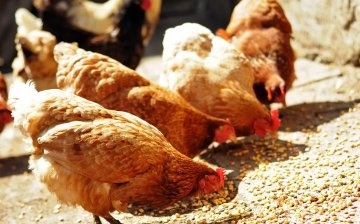
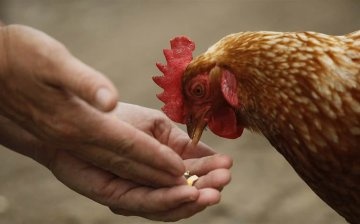
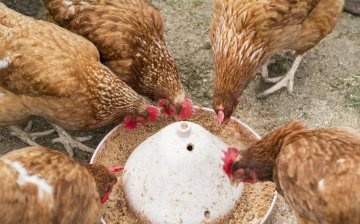



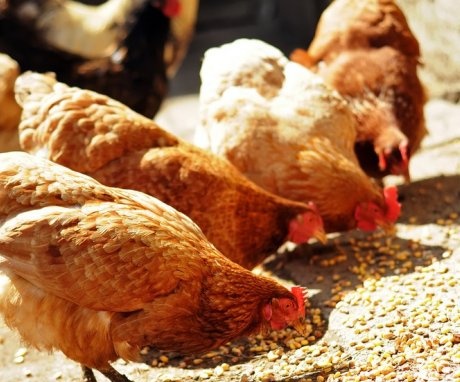
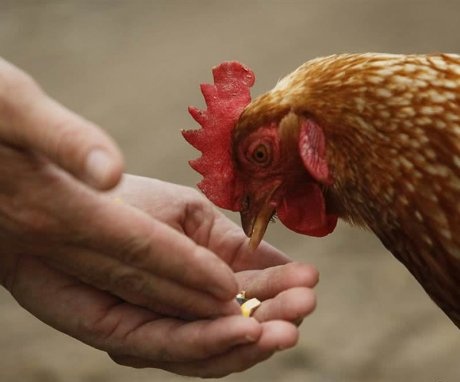
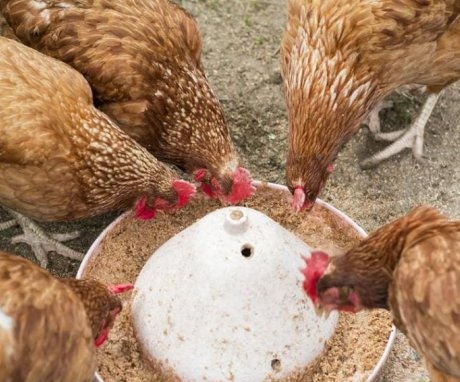
Judging by the recommendations in the article, chickens need to be fed to everyone, cereals, vegetables, grass, and they should also have chalk and sand available, but I would not recommend slaked lime, since it is extinguished very slowly and small inclusion of unslaked lime.
In principle, chickens are quite omnivorous. Of course, they prefer grains and greens, but they never give up vegetables and fruits. It is important to solve the problem of the source of calcium, in addition to inert flour, we use crushed shells and special additives.